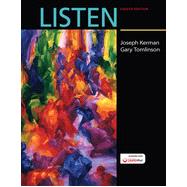Notice:
Kerman/Tomlinson, Listen, Eighth Edition is moving to W.W. Norton and Company Publishers. For instructors and students currently using Listen, W.H. Freeman will continue to support your teaching and learning with the textbook and its accompanying print and media resources, including LaunchPad, until July 31, 2015. Instructors interested in using Listen after August 1, 2016, should contact Norton.
Generations of students have developed a love of music and focused listening skills through the enjoyable prose, high-quality recordings, unmatched Listening Charts, and historical context in Listen.
In the eighth edition this classic text gets a fresh face, with a new design that enhances its clarity and accessibility, new features that help students review and synthesize important concepts, new perspectives on twentieth-century music, and new repertory that enhances students’ exposure to the forms and genres of classical music. With an array of media options including CDs, downloads, and LaunchPad with streaming music, Listen works well for any course format and any budget.








